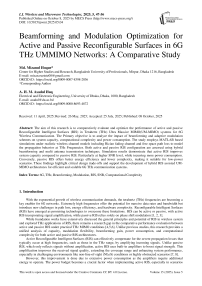Beamforming and Modulation Optimization for Active and Passive Reconfigurable Surfaces in 6G THz UMMIMO Networks: A Comparative Study
Автор: Md. Mizanul Hoque, A.H.M. Asadul Huq
Журнал: International Journal of Wireless and Microwave Technologies @ijwmt
Статья в выпуске: 5 Vol.15, 2025 года.
Бесплатный доступ
The aim of this research is to comparatively evaluate and optimize the performance of active and passive Reconfigurable Intelligent Surfaces (RIS) in Terahertz (THz) Ultra Massive MIMO(UM-MIMO) systems for 6G Wireless Communication. The Primary objective is to analyze the impact of beamforming and adaptive modulation schemes on system capacity, computational complexity and power consumption. The study employs MATLAB based simulations under realistic wireless channel models including Rician fading channel and free space path loss to model the propagation behavior at THz Frequencies. Both active and passive RIS configuration are assessed using hybrid beamforming and multi antenna transmission techniques. Simulation results demonstrate that active RIS improves system capacity compared to passive RIS. Particularly at higher SNR level, while incurring more power consumption. Conversely, passive RIS offers better energy efficiency and lower complexity, making it suitable for low-power scenarios. These findings highlight critical design trade-offs and support the development of hybrid RIS assisted UM-MIMO architectures for efficient and scalable 6G THz communication systems.
6G, THz, Beamforming, Modulation, RIS, SNR, Computational Complexity
Короткий адрес: https://sciup.org/15019963
IDR: 15019963 | DOI: 10.5815/ijwmt.2025.05.04
Текст научной статьи Beamforming and Modulation Optimization for Active and Passive Reconfigurable Surfaces in 6G THz UMMIMO Networks: A Comparative Study
With the exponential growth of wireless communication demands, the terahertz (THz) frequencies are becoming a key enabler for 6G networks. Extremely high frequencies offer the potential for massive data rates and bandwidth but introduce new challenges in path loss, energy efficiency, and hardware complexity. Reconfigurable Intelligent Surfaces (RIS) have emerged as promising technologies to overcome these limitations. RIS can be active or passive, with active RIS incorporating signal amplification, while passive RIS relies solely on phase shift modulation [1, 2, 3].
While foundation works have extensively discussed the general principles and potential of RIS in wireless system and explored THz applications of RIS, there remains a research gap in the comparative performance evaluation between active and passive RIS under practical THz MIMO conditions [4,5,6]. Unlike previous studies, this research provides a unified analysis of capacity, modulation flexibility, beamforming gain, power consumption, and computational complexity for both active and passive RIS architectures.
Active Reconfigurable Intelligent Surfaces (RIS) can effectively compensate for the severe propagation losses that typically occur at high frequencies, such as those in the THz range, by amplifying incoming signals. Unlike passive RIS, which only reflects signals without amplification, active RIS uses built-in amplifiers to boost signal strength. This amplification improves the received signal quality, extending the coverage range and enhancing system performance, especially in challenging environments like non-line-of-sight (NLoS) conditions or highly obstructed scenarios [7, 8].
However, this improvement is done due to extensive power consumption as the amplifiers require additional energy to operate. The power budget becomes a crucial factor when implementing active RIS, especially in scenarios where low power consumption is prioritized, such as battery-operated devices in IoT networks [9, 10]. Figure 1., shows an improvement in the coverage for the distant user while using Active RIS.
Furthermore, the use of active RIS increases the overall computational complexity of the system. The need to manage amplification, phase shifts, and possibly interference mitigation requires sophisticated algorithms that place additional demands on the processing power of the system. These algorithms must balance the trade-offs between power usage, signal amplification, and other factors like beamforming precision and adaptive modulation. Consequently, while active RIS offers significant performance benefits, its implementation must carefully account for both energy efficiency and computational load to ensure an optimal balance between performance and resource utilization [11, 12].
Passive reconfigurable intelligent surfaces (RIS) in contrast operate without any active amplification of the signal. They are based solely on intelligent reflection and reconfiguration of incident electromagnetic waves to enhance signal strength in specific directions. This approach makes passive RIS highly power efficient, as they do not require external power for signal amplification, only needing minimal energy to adjust the phase shifts of the reflected signals [13, 14].
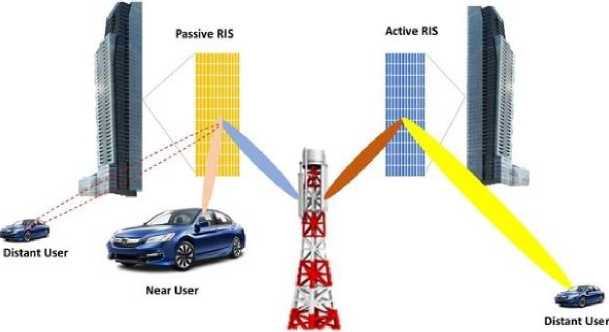
6G Base Station
Fig. 1. Coverage Comparison while using Active and Passive RIS for Distant user
Table 1. Basic Comparison between Active and Passive RIS
|
Aspects |
Active RIS |
Passive RIS |
|
Power Source |
Requires an external power source for signal amplification |
no external power source; reflects signals passively. |
|
Signal Amplification |
Capable of amplifying incoming signals |
No signal amplification, only reflection or phase shift |
|
Energy Consumption |
higher due to active components (amplifiers) |
Very low as no active components are used. |
|
Complexity |
More complex design and circuitry due to active elements |
Simpler design as no active electronics are involved |
|
Cost |
More expensive due to additional components (e.g., amplifiers) |
Cost-effective as it lacks amplifiers and other active components |
|
Performance Enhancement |
Can significantly improve signal strength, range, and coverage |
Improves signal propagation by optimizing reflection paths without increasing signal strength. |
|
Noise |
Introduces some noise due to active elements |
0No additional noise, as it operates passively |
|
Coverage Range |
Larger coverage due to signal amplification. |
Limited to the reflection area, without amplification |
|
Application Scenarios |
Suitable for scenarios requiring extended range and coverage |
Ideal for low-power, low-complexity applications, where signal boosting is not necessary. |
|
Maintenance |
Requires regular maintenance due to active components. |
Minimal maintenance as there is no active elements. |
|
Deployment Challenges |
Requires careful power management and cooling systems. |
Easier to deploy due to passive operation. |
However, due to the absence of amplification, passive RIS generally exhibits reduced performance in long-range communication scenarios or environments with significant path loss. The lack of signal boosting means that passive RIS are less effective in overcoming severe attenuation, making them more suitable for shorter-range applications or situations with fewer obstacles between the transmitter and receiver. As a result, while passive RIS offer a cost-effective and energy-efficient solution, especially in low-power networks like IoT, their ability to significantly improve communication quality diminishes in environments where long-range coverage or high propagation losses are a concern. This trade-off between energy efficiency and communication range makes passive RIS ideal for certain applications but limits their use in scenarios demanding higher signal strength and broader coverage [15, 16, 17, 18, 19]. A summarized approach is given in Table 1
In this research, researchers focus on optimizing beamforming and modulation for both active and passive RIS in THz MIMO networks. Researchers investigate how different modulation schemes, such as BPSK, QPSK, and QAM, impact the capacity and efficiency of the system and examine the computational complexity associated with beamforming and modulation processing.
Previous research has explored the potential of RIS for 5G networks, showing how these intelligent surfaces can improve spectral efficiency and overcome path loss issues. However, with the transition to the 6G and THz frequencies, the unique challenges posed by higher frequencies necessitate a deeper understanding of RIS performance. Active RIS has shown the ability to enhance signal propagation, while passive RIS remains a power-efficient alternative. Our work aims to expand on this by incorporating beamforming and modulation optimization in a comparative framework for THz
MIMO systems [20, 21, 22, 23, 24, 25, 26].
2. System Model and Methodology 2.1. System Architecture
Researchers consider a THz communication system with a base station equipped with multiple antennas (MIMO) and a RIS module placed between the transmitter and receiver to assist the signal transmission. The researchers’ study both active and passive RIS, where the RIS elements are configured to optimize beam formation and modulation.
-
2.2. Channel Model
-
2.3. Beamforming Optimization
-
2.4. Modulation Schemes
-
2.5. Computational Complexity
-
2.6. Performance Metrics
Researchers assume a Rician fading channel model with line-of-sight (LOS) and non-line-of-sight (NLOS) components. The path loss is modeled using the Friis free-space equation, and the fading is simulated based on a Rician K-factor to represent the effect of THz propagation environments.
Beamforming in the RIS is performed by adjusting the phase shifts of the RIS elements. For active RIS, researchers include an amplification factor in the beamforming gain, while passive RIS only alter the phase of incoming signals. The objective is to maximize the signal-to-noise ratio (SNR) at the receiver.
Researchers consider several modulation schemes like BPSK, QPSK, 16-QAM, 64-QAM and 256-QAM. The modulation is adapted on the basis of the SNR, with higher-order schemes used when the SNR allows more bits per symbol. This adaptive modulation helps optimize capacity while maintaining signal quality.
The computational complexity of the system is modeled as the sum of MIMO operations, modulation/demodulation processing, and beamforming phase calculations. Active RIS are expected to incur higher computational costs due to the additional signal amplification step.
Researchers evaluate the following key metrics:
• Capacity: The achievable data rate based on the Shannon capacity formula.
• Power Consumption: The power required for signal transmission and RIS operation.
• Modulation Order: The highest modulation scheme that can be supported based on the SNR
• Computational Complexity: The number of operations required for beamforming, modulation, and amplification.
3. Equations
3.1. Signal-to-Noise Ratio (SNR)
For passive and active RIS systems:
SNR
=
^tx . ^mimo , passive No
G^^active
_ ^tx . ^mimo , active
No
Where, ^tx = Transmit power
, = UMMIMO gains for passive RIS
^mimo , active = UMMIMO gains for active RIS
-
N 0 = Noise powers
-
3.2. UMMIMO
^mimo =| ^mimo
^mimo =√ I (* + jY ) (4)
Where,
^mi = MIMO channel matrix.
X and Y are independent real Gaussian random matrices representing the real and imaginary components, respectively.
-
j is the imaginary unit.
-
3.3. Path Loss Model
This channel matrix accounts for the random nature of UM-MIMO wireless channels in THz networks, with X and Y typically following a normal distribution N (0,1). Rician Fading Gain:
Grici
Where,
K is the Rician K-factor.
Free Space Path Loss model is appropriate for LOS-dominant THz links. It reflects a path loss exponent, aligning with theoretical and empirical THz propagation models.
For free-space path loss:
GfSpi = ( )
Where,
-
λ = the wavelength.
-
d is the distance from the transmitter to the receiver.
-
c is the speed of light.
-
3.4. Modulation aware Capacity extension:
Further align with real world THz scenarios, researcher integrated adaptive modulation into the capacity analysis Depending on the SNR at each point in the RIS user link, a corresponding modulation order M is selected. For both passive and active RIS systems, the modulation aware capacity is defined as:
c = . log2 (1+ SNR ). log2 ( M ) (7)
Where,
C is the channel capacity (bits per second).
B is the bandwidth.
SNR is the signal-to-noise ratio.
M is the modulation order.
3.5. Power Consumption
For active and passive RIS:
|
p = + , active + |
(8) |
|
1 total , passive 1 tx |
(9) |
Where ^amplifier is the power consumed by the active RIS amplifiers.
-
3.6. Computational Complexity
This reflects practical implementation differences and supports comparative hardware cost analysis in THz UM-MIMO systems.
Ptx is the transmit power.
CoTnplexitypassive = ( Nr + ^t )+ 0 ( ) (10)
Complexity active = + ^a (11)
Where,
Nr x Nt is the MIMO complexity
N is the number of RIS elements,
-
α is the amplification factor for active RIS.
-
3.7. Beamforming Gain
The expression of beamforming gain captures constructive interference when phase shifts Фп are optimized, which is critical for evaluating RIS-assisted signal enhancement in THz systems.
For beamforming gain with phase shifts:
G = |∑ e - IK
u beam forming IZun=1
Where,
N = Number of RIS elements, ϕ n = Amplification factor for active RIS.
4. Simulation Setup
This study utilizes MATLAB-based simulations to evaluate the contribution of active and passive RIS-assisted UM-
Table 2. Simulation Parameters
|
SL No. |
Parameter |
Element |
|
1 |
Frequency |
140 GHz |
|
2 |
Transmit power |
40 Watt |
|
3 |
Noise power |
1e-9 Watt |
|
4 |
Bandwidth |
1 GHz |
|
5 |
Number of RIS elements (N) |
500 |
|
6 |
Distance from RIS to receiver |
500 m |
|
7 |
Amplification factor for Active RIS |
10 |
|
8 |
Channel Model |
Rician Channel (K=10) |
|
9 |
Rician Channel Gain (Passive) |
G fspl * Rician Channel Coefficient |
|
10 |
Rician Channel Gain (Active) |
Amplification factor for Active RIS * Rician Channel Gain (Passive) |
|
11 |
Power consumption for Active RIS |
1 Watt |
|
12 |
Power consumption for Passive RIS |
0.005 Watt |
|
13 |
Number of users in the network (M) |
20 |
|
14 |
Number of transmit antennas (UM-MIMO) |
1024 |
|
15 |
Number of receive antennas (UM-MIMO) |
1024 |
|
16 |
Amplification Factor for Active RIS ( a ) |
10 |
|
17 |
Complexity |
Eqn (10) and Eqn (11) |
MIMO systems in the THz band. A free-space path loss (FSPL) model with a path loss exponent of 2 is adopted, reflecting LOS-dominant propagation. The channel is modeled using a Rician fading distribution with a K-factor of 10, representing realistic urban THz environments. The system configuration includes 1024 transmit and receive antennas, 500 RIS elements, and 20 users, consistent with ultra-massive MIMO and dense RIS deployments envisioned for 6G. Transmit power is set at 40 W with a noise floor of 1e-9 W, aligning with 6G link budget assumptions. An amplification factor of 10 is applied to active RIS to assess gain-power trade-offs. Adaptive modulation is implemented based on practical SNR thresholds for BPSK to 256-QAM. Randomized beamforming phase shifts emulate dynamic beam alignment under imperfect CSI. Computational complexity is evaluated primarily through matrix operation order (Nr × Nt) and constant-time modulation and capacity calculations.
Table 2, The simulation setup using MATLAB provides a robust framework to conduct a comparative analysis of beamforming and modulation techniques on active and passive RIS within a 6G THz UM-MIMO network, covering both technical configurations and performance metrics to highlight the benefits and trade-offs of each approach. Adjust specific parameters as needed based on system and research focus.
5. Results and Discussion 5.1. SNR Analysis
When comparing SNR vs distance for Active and Passive RIS, the key difference lies in the amplification ability of Active RIS. Passive RIS reflects signals without amplifying them, resulting in a rapid decline in SNR as the distance between the transmitter and the receiver increases due to path loss [27, 28, 29]. This leads to significant signal degradation over larger distances. However, Active RIS incorporates amplification, which compensates for the increased path loss, maintaining a higher SNR even at extended distances. As a result, Active RIS offers better signal quality and coverage range compared to Passive RIS, particularly in scenarios where long-distance communication is critical [30, 31]. This comparison of Figure 2. highlights the importance of amplification due to the inherent limitations of signal attenuation in RIS-assisted THz networks. Along with showing how SNR degrades with distance, the steeper drop in passive RIS due to lack of amplification and include confidence intervals over multiple Monte Carlo Simulations.
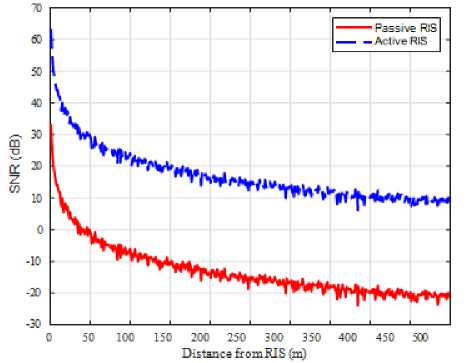
Fig. 2. SNR Vs Distance for Active and Passive RIS
-
5.2. Capacity Analysis
-
5.3. Modulation Scheme Selection
-
5.4. Power Consumption and Efficiency
-
5.5. Computational Complexity
Figure 3. shows the capacity of active and passive RIS systems as a function of the distance between the RIS and the receiver. Active RIS demonstrates higher capacity across all distances as a result of amplification of the signal. However, the difference between active and passive RIS is minimal at short distances, suggesting that passive RIS can be energy- efficient maintenance for short-range THz communication.
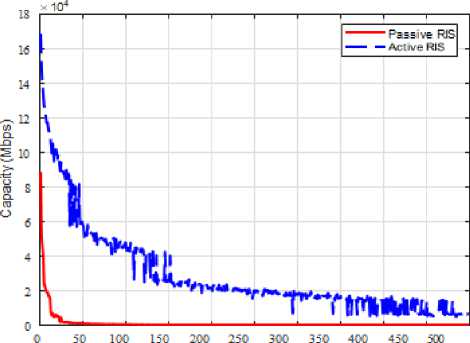
Distance tromRIS fm)
Fig. 3. Rician Channel with UMMIMO and Capacity
Figure 4. depicts the modulation scheme adopted for different SNR values at varying distances. Both systems switch to higher-order modulation (256-QAM) when the SNR is high, but active RIS maintain higher modulation orders at longer distances, as shown by the SNR thresholds in the graph.
Figure 5. compares the power consumption of active and passive RIS. As expected, active RIS consume significantly more power due to signal amplification, making passive RIS a better option for low-power applications.
The complexity results in Figure 6. show that active RIS incur a higher computational cost, particularly in scenarios with larger arrays of RIS elements and higher-order modulation schemes. The increase in complexity is a tradeoff for the performance gain in capacity and coverage.
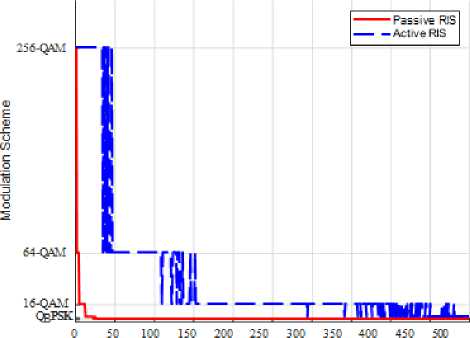
Distance tromRIS (in)
Fig. 4. Rician Channel with UMMIMO and Modulation Scheme Vs Distance
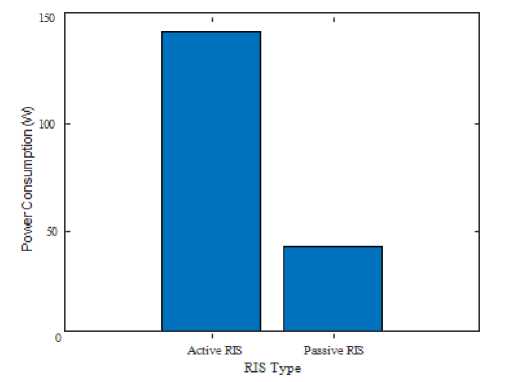
Fig. 5. Power Consumption for Active and Passive RIS
As 6G networks evolve ultra dense deployments scalability will become a key concern. The proposed RIS assisted THZ system must account for increased user density, larger antenna arrays, and distributed RIS deployments. With more users’ resource allocation, and beam alignment grow in complexity, requiring efficient scheduling and clustering algorithms. Similarly, massive antenna arrays introduce computational overhead for beamforming optimization. Distributed RIS architectures further demand coordination strategies to avoid interference and enable seamless handover.
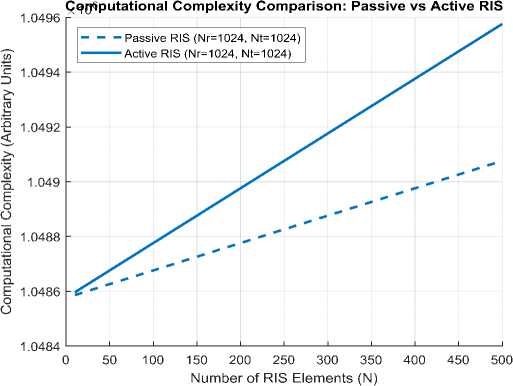
Fig. 6. Computational Complexity Active vs Passive RIS
6. Conclusion
This study presented a comparative analysis of active and passive Reconfigurable Intelligent Surfaces (RIS) in THz MIMO networks, focusing on beamforming and modulation optimization. While active RIS demonstrated higher capacity and modulation adaptability, particularly beneficial in long range scenarios, this comes with significant power consumption and computational complexity. Passive RIS though less flexible offer energy efficient performance suitable for short range communications.
However, this analysis assumed idealized conditions such as perfect CSI and static user positions, which may not hold in practical deployments. Implementation challenges such as real time beam alignment, thermal management for active RIS and scalability of control mechanisms also remain open issues. Future work will explore hybrid RIS architectures and adaptive control schemes to better balance performance, efficiency and deployment feasibility in real world 6G environments. One limitation, of this study is its reliance on MATLAB based simulations. While this enables scalable and configurable analysis, it does not account for hardware imperfections or real-world propagation effects. Future work will also focus on validating the proposed model using hardware testbeds and measured channel data to improve deployment readiness and generalizability. Additionally, relay assisted RIS configuration can enhance coverage in obstructed THz scenarios, while machine learning based optimization techniques such as deep reinforcement learning or meta learning can dynamically adapt beamforming and resource allocation in real time environments.
Acknowledgment
This research was supported by the Academic Council of Bangladesh University of Professionals (BUP) in its 70th meeting held on 20 July 2O23. PhD Reg Num: 100401210010. The author would like to thank Dr. A.H.M. Asadul Huq for his guidance, supervision, and insightful comments during the study. The authors also acknowledge the assistance of their colleagues for their help with data analysis and manuscript preparation.

